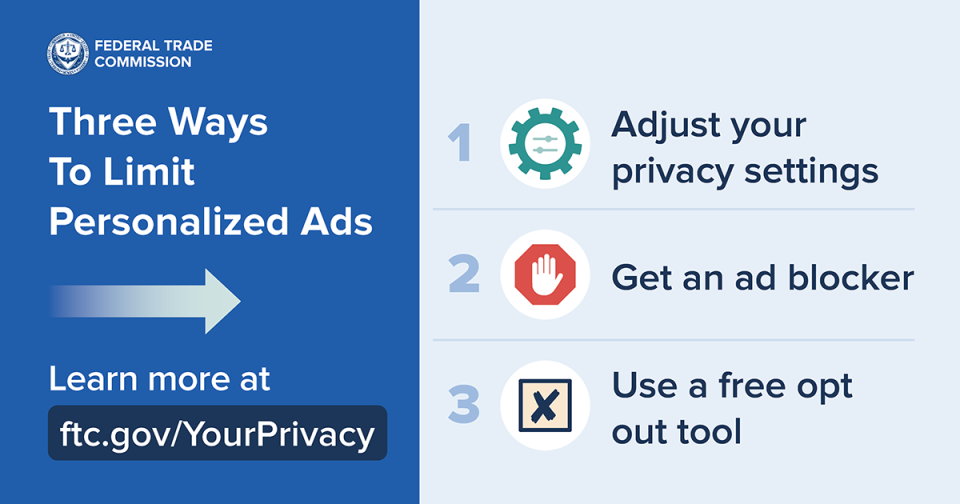How and Why Websites and Apps Track You Online
Websites and apps use different technologies to collect information about what you do online. Websites may track your online activity by using a cookie or pixel to identify you even after you leave the site. Or they may use device fingerprinting — a technique that uses your browser’s unique configurations and settings to track your activity. When you use an app on your smartphone, advertisers may use a unique advertising identifier to track you. Companies also may track your activity on different internet-connected devices, like your laptop and your smartphone.
So why do companies want to track your online activity? They might do so to
- save your preferences and information, like your username or things you left in your shopping cart
- show you personalized content like local weather and stories about topics you’re interested in
- gather analytics about your visit to a website, like the pages you visited, how much time you spent on the site, and the type of device and browser you used
- remember the things you searched for online
- show you personalized ads based on your browsing history or your location
When a website you visit tracks you, that’s first-party tracking. When a website you visit lets another company track you, that’s third-party tracking.
Third-party tracking companies can track you across most websites you visit. Third-party tracking lets advertisers show you targeted ads based on your interests and online activity. For example, if you visit a website about running and fitness, you might see ads for running shoes when you visit other websites.
What To Do About Online Tracking and Personalized Ads
Delete your history
If you don’t want to see ads based on your previous online activity, delete cookies and clear your browsing and search history. On your phone, delete or reset identifiers used to track you.
Adjust your privacy settings
The privacy settings in your browser give you some control over the information websites collect about you. For example, you can choose to block websites from seeing your browsing history. Or choose not to share your location with them. The protections vary by browser. Some have a private browsing mode that deletes your browsing history after you end your session, but it doesn’t block websites from seeing your online activity. There also are browser extensions, or plug-ins, that give you some privacy controls. If you’re considering one, read reviews from reputable sources to learn what options they offer.
Your browser’s privacy settings also let you choose whether to allow or block personalized ads based on your browsing history. And your phone also has a setting that lets you opt out of personalized ads from the company that makes the operating system (for example, Apple or Google). You’ll find this setting in the “advertising” section of your phone’s privacy settings. In all these cases, you’ll still see ads, but they won’t be personalized based on your browsing history.
If you have an internet-connected TV or streaming device, review the privacy settings and permissions on those, too.
Social media, and other apps, may also track your online activity. Go to your account settings to see how they use your information and adjust your settings to match your preferences.
Some apps may ask for access to information from your device, like your location, your contacts, or your photos. Go to the privacy settings on your smartphone to see what information they can access from your device. Consider turning off unnecessary permissions or deleting apps that request a lot of permissions they don’t need to function.
See How To Manage Your Privacy Settings in Different Browsers for more details.
Consider using an ad blocker
Ad blockers keep ads from appearing on your browser. They work by filtering specific content according to rules set by the program or the user. Some ad blockers let you block pixels and other trackers from gathering data on you. But ad blockers don’t necessarily block all ads or tracking. That’s because some show ads from advertisers that meet certain criteria set by the company. Ad blockers also don’t detect or block viruses or malware.
There are many ad blockers available online. If you’re considering one, read reviews from reputable sources to learn about their features and decide which ad blocker is best for you.
Opt out of personalized ads
Advertising industry groups have free tools that let you control how participating advertisers use your information. These tools are available for your browser, your phone, your tablet, and, in some cases, your streaming devices and smart TVs. If you opt out, be sure to opt out on each device and browser.
Review website cookie notices
When you visit some websites, you may see a notice about how the website uses cookies. The notice may let you choose what type of cookies to allow: those choices often include allowing only cookies that are necessary for the site to function or allowing the site to use cookies for advertising and other purposes. Choose the option that best fits your preferences.

How To Manage Your Privacy Settings in Different Browsers
Apple Safari
Google Chrome
- Delete your browsing history
- Manage cookies
- Private browsing
- Tracking permissions
- Location sharing
- Personalized ads
